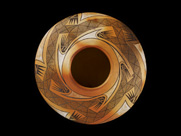We're open daily! View holiday hours
Science News
2000 Years of Native Pottery
October 25, 2011
by Russ Hartman

This is the second installment on the Academy’s current exhibit “Evolving Traditions: Southwest Native Pottery and Silver,” located in the Upper Gallery on Level 3. The first post can be found here.
Native Americans in the Southwest have been making pottery for almost 2,000 years, while raising the craft to the level of art since the late 1800s. The pottery has changed dramatically in some ways, while core cultural traditions and an ingrained respect for Mother Earth and her clay have remained constant, sustaining this ancient craft within their specific tribal groups.
Surprisingly, archaeologists will probably never be able determine exactly when and where pottery production began in the American Southwest. The craft began showing up in the archaeological record only around AD 200 at Mogollon sites in east-central and southeastern Arizona and only slightly later at Ancestral Pueblo (formerly called Anasazi) sites in the Four Corners region. Ultimately, the tradition can be traced back to Mexico, but it took a long time to spread to the American Southwest.
Two pottery-making techniques are used by today’s native potters. Maricopa potters in the Phoenix area employ the paddle and anvil technique, while other pottery producing groups (all Pueblos and the Navajo) all begin a pot by hand, forming a pancake-like base and then complete the vessel with the coiling technique.
Passing the native potters’ tradition down to new generations can be a lengthy process. In addition, the vital steps of the craft—gathering raw clay, sifting and curing it, and polishing pots—involve communal labor and strengthen family ties. Children are encouraged to participate from the time they are very young, and are given increasingly more responsibility as they master each step. Sitting alongside their relatives, younger potters are shown how to do each step, but are never told, “Do it this way.”
The celebrated Maria Martinez of San Ildefonso Pueblo always relied upon a family member to help paint her pottery, but younger, contemporary potters are more likely to complete each step of the process themselves, while being guided by recollections of how they were originally taught or their own experiences to help them to “read” and “feel” the clay. Today’s potters also have considerably more artistic freedom to experiment with new shapes, designs, colors and textures. As they incorporate experiences from the modern world, collectors, too, have a much broader concept of Native American art and readily encourage innovation.
“Evolving Traditions” presents examples of pottery from many different tribal groups, allowing for the comparison of the vessel forms, designs, and colors from one group to another. All of the pots are made from clay, but no two clay deposits are the same and the traditions of one tribe or pueblo also differ markedly from each other.
Russ Hartman is Senior Collections Manager of Anthropology at the California Academy of Sciences.